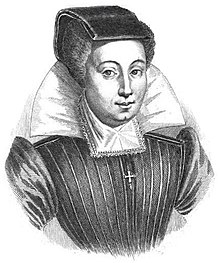Louise Boursier | |
|---|---|
 | |
| Born | 1563 |
| Died | 1636 (aged 72–73) |
| Citizenship | French |
| Education | During childhood was probably tutored in the humanities; taught herself midwifery by reading the writings of the obstetrical innovator Ambroise Paré and possibly by obtaining tips from her surgeon husband (who worked under Paré for twenty years). Also observed both deliveries and the autopsies of women who died in childbirth at the poor hospital in Paris. |
| Known for | Scholarly as well as empirically based writings on midwifery and gynecology that include innovative protocols for delivering malpresenting fetuses. Became royal midwife to French royal family and delivered the future Louis XIII and his five siblings. Bourgeois’s successful delivery of the future Louis XIII helped bring about peace and prosperity in the realm after many decades of dynastic and religious war. Known for being the first woman to write a printed medical text in France. |
| Spouse(s) | Martin Boursier, army surgeon |
| Scientific career | |
| Fields | Midwifery, gynecology |
| Institutions | Courts of Henry IV of France and Louis XIII of France |
| Patrons | Queen Marie de Médicis, Louis XIII |
Louise (Bourgeois) Boursier (1563–1636) was royal midwife at the court of King Henry IV of France and the first female author in that country to publish a medical text.[1] Largely self-taught, she delivered babies for and offered obstetrical and gynecological services to Parisian women of all social classes before coming to serve Queen Marie de Medicis in 1601.[2] Bourgeois successfully delivered Louis XIII, King of France (1601) and his five royal siblings: Elizabeth, Queen of Spain (1602); Christine Marie, Duchess of Savoy (1607); Nicolas Henri, Duke of Orléans (1607); Gaston, Duke of Orléans (1608); and Henrietta Maria, Queen of England, Queen of Scots, and Queen of Ireland (1609). In 1609, Bourgeois published the first of three successive volumes on obstetrics: Observations diverses sur la sterilité, perte de fruict, foecondite, accouchements et maladies des femmes et enfants nouveaux naiz / Amplement traictees et heureusement praticquees par L. Bourgeois dite Boursier (Diverse observations on sterility, miscarriage, fertility childbirth, and diseases of women and newborn children amply treated and successfully practiced). Subsequent volumes were published in 1617 and 1626, also in Paris.[3]
These publications include observation-based, innovative obstetrical protocols to manage difficult births as well as advice for pregnant and postpartum mothers and newborns. Bourgeois also offered recipes for various kinds of medications that would have been easy for a woman to make herself. The three volumes include over four dozen detailed case histories that made a substantial contribution to the emerging empiricism of seventeenth-century European science and medicine.[4]
Overall, Bourgeois’s mission was to educate midwives so that they could become more competent at caring for women’s obstetrical and gynecological needs as well as to inform women about how to care for their bodies themselves.[5] At a time when the best trained and most skilled midwives of Paris were competing for elite clients—who had begun to prefer male surgeons not only for difficult but also for normal births[6]—Bourgeois called out midwives, surgeons, and physicians alike for their incompetence and ignorance when it came to the care of pregnant, parturient, and postpartum mothers.[7] Moreover, Bourgeois envisioned a collaborative rather than hierarchical relationship among trained midwives, surgeons, and physicians, one that would serve the best interests of mother and child.[8]
Bourgeois’s works were as popular in her day as those of male medical authors like Ambroise Paré and Jacques Guillemeau.[9] Even after her death she enjoyed fame and influence in France and beyond. Her work is reflected in Jane Sharp's The Midwives Book: Or the Whole Art of Midwifry Discovered (1671); Marguerite du Tertre de la Marche's Instruction familière et utile aux sages-femmes pour bien pratiquer les accouchemens (1677); and Justine Siegemund's Die chur-Brandeburgische Hoff-Wehe-Mutter (1690).[10] Also following Bourgeois's example was Angélique Marguerite Le Boursier du Coudray (c. 1712–1794); it is unknown whether du Coudray was related to Bourgeois.[11]
Bourgeois's career as a royal court midwife spanned more than twenty-six years. She was paid 900 livres for each of the last four of Louis XIII's siblings' births, a sum eight times greater than the average municipal midwife's salary.[12] In 1608, she received an additional sum of 6000 livres, most likely in recognition of her superior services to the royal family.[13] After the birth of Marie de Médicis’s last child in 1609, Bourgeois asked for a pension. King Henry IV agreed to 900 livres, which was considered a reasonable retirement income.[14]